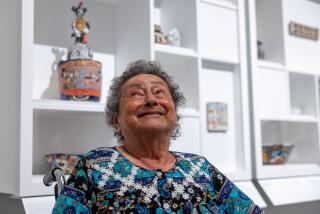Puppet Master Has the World on a String
- Share via
‘Each of my puppets has its own name and separate personality. I love my puppets. They pay the rent here.’
--Gary Jones
Gary Jones’ quest for a successful theatrical career has always had strings attached.
Two years ago, in hopes of embarking on a television career, he left his Chicago loft and moved to Los Angeles. The move was no easy task because 160 members of the Jones family always travel with him.
The family members, who are 3 feet tall and have names like Sweet Georgia Brown, Mr. Stomp, Paris Model and Porsche, are his handmade creations. Jones, a 44-year-old master puppeteer, is the owner of Blackstreet U. S. A. Puppet Theatre, which has settled in a converted storefront theater at 4619 W. Washington Blvd. in West Los Angeles.
“Each of my puppets has its own name and separate personality,” Jones said. “I love my puppets. They pay the rent here.”
The theater contains a small platform stage and two rows of folding chairs, capable of seating up to 40 people. The walls of the high-ceilinged room are lined with dozens of puppets, each with exaggerated features and dressed in various customs. In the back of the store, Jones has a workshop where he repairs worn-out puppets and painstakingly creates new ones. He lives in a room over the workshop.
Jones, who is trim and long-limbed like his puppets, performs alone on stage, dancing his way through routines, manipulating one puppet at a time to a collection of jazz, funk and classical music. He is currently performing evening shows for adults and weekend matinees for children. Both have received favorable reviews in The Times and other area newspapers.
The adult show delves into the lives of 12 young urban professionals affectionately called “The Yuppets.”
“It is a comment on materialism and greed,” Jones said. “It involves each puppet’s reaction to the dollar bill.”
Response to Greed
The show, Jones said, was his response to seeing the “overwhelming wealth and greed contrasted with the problems of the homeless and the needy” in Los Angeles.
Bob Baker, who operates the oldest and largest puppet theater in Los Angeles, Bob Baker Marionettes, said he saw Jones’ performance four times.
“I love the way he involves himself on stage with the puppets and the audience,” he said. “He gets on the floor and dances with the puppets and becomes part of the show.”
Before moving west, Jones’ career in Chicago was well-established. He had earned such recognition that his company, which then consisted of as many as 40 artists, was invited to perform at the Smithsonian Institution in Washington. The theater also performed in West Germany, Holland and Portugal.
“I moved from Chicago because I felt I had taken the art of puppetry as far as I could take it,” he said. “I wanted to be in the kind of situation that would force me to grow.”
Saw ‘Madame Butterfly’
Jones said he was first introduced to the world of puppetry at the age of 17 when he saw a production of “Madame Butterfly” at Chicago’s Kungsholm Miniature Grand Opera. Ten years later he persuaded the Kungsholm to hire him as scenic designer. He started work in 1967 with “Porgy and Bess” and remained with the company until it closed in 1970.
By then, he said, he had enough experience to run his own company. He began making the intricate “rod puppets” he now uses in his performances. He holds the puppet by a rod extending from its back and uses his other hand to manipulate the eyes and mouth.
Jones sculpts the head of each puppet in clay and then casts it in plastic wood. Ping-Pong balls are used for eyes and springs are installed to operate the mouth and eyelids. The arms, torso and legs are clothed to portray characters--business executives, artists, minstrels, dancers and a variety of street people.
“The puppet theater has an obscure position in the arts today because many people consider it to be children’s entertainment or less than entertainment for adults,” Jones said. “That is not necessarily true. The difficulty I face is getting people inside. Once they are here, they are gripped by the show.”
The children’s show is “refreshing,” said Charles Bouldin, a teacher who recently brought his students from nearby Thompson’s Learning Village, a private elementary school, to a performance.
‘Children Really Relate’
“It is something that the children really relate to,” he said.
Jones performs Mother Goose fables and an original work called “The Little Girl Who Loved to Dance.” Jones said that the message conveyed in his work is that it is important to make your own decisions.
In the work, the little girl puppet wants to emulate another puppet named Judith, an elegant dancer with flowing white gown and long limbs. The dancer is one of the few puppets that Jones has modeled after a person, dancer Judith Jamison of the Alvin Ailey Dance Company.
Normally, Jones said he is reluctant to say that he has favorites among his puppets. “The puppets might get jealous,” he said with a laugh. Judith, however, is one of his favorites.
He also said he talks to his puppets even when he is not on stage.
“It may seem strange,” he said. “But every artist talks to himself when trying to create. Dancers talk to themselves and musicians do too. The only difference is I often have the puppets respond to what I’m saying because it is a way to remain in character. It is a constant rehearsal.”
Tickets for performances at the Blackstreet theater cost $5 for adults and $3 for children.
More to Read
The biggest entertainment stories
Get our big stories about Hollywood, film, television, music, arts, culture and more right in your inbox as soon as they publish.
You may occasionally receive promotional content from the Los Angeles Times.










